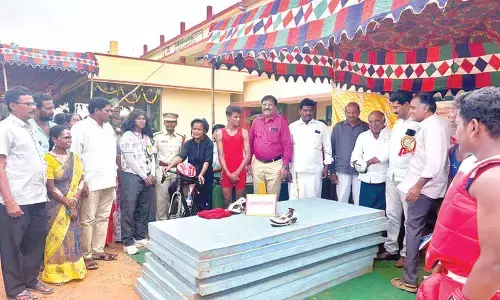Why so much resistance to the idea of natural farming?

I am standing on a sun-baked landscape, barren and desolate as far as the eye can see.
I am standing on a sun-baked landscape, barren and desolate as far as the eye can see. This is Ananthapuramu district of Andhra Pradesh, where the rain this year was less than normal, and farmers missed the sowing season. But as I look down, I can see signs of crop life bursting.
T Vijay Kumar, who heads the state government’s community-managed natural farming programme called Rythu Sadhikara Samstha, explains that the crops are growing from pelletised seeds — in this method, farmers coat the seeds with materials like cow dung and ash, and then plant them in circles with minimal disturbance to the soil. These seeds can lay in the soil for 30 to 45 days, waiting for as little as 5-10 mm of rain to sprout.
Another risk-mitigation measure is planting a variety of crops, from red gram to castor oil plant to beans. The women farmers tell me that this technique has allowed them to cultivate during a season that would have gone to waste. In our climate-risked times, when rainfall will become even more variable, this is the reworking of farm practices we desperately need.
We then go on to visit more farmers practising what is called natural farming. I wanted to understand how different this practice is from what we know as organic or non-chemical farming. Field after field, we see a combination of trees and food crops. I can see arecanut, moringa tree (drumstick) and papaya on the farm boundaries and vegetables like beetroot, spinach and beans, all growing with millets, corn and even lentils. Everything is growing in profusion, but without any order, or at least that is how it seems to me.
But then Lakshma Naik, chief technology and innovation officer of Rythu Sadhikara Samstha, tells me that there is an order to this cultivation. The objective is to build a web of plants so that this biodiversity can regenerate the soil structure with different fungi and bacteria. The objective is also to provide farmers income from diverse crops with different durations. Naik calls this particular model ATM or Anytime Money. It’s a bonanza of crops, all grown using only natural fertilisers or bio-stimulants.
What excites me is the incredible scale of this programme, which covers every district of Andhra Pradesh. The programme, initially called zero-budget farming, was started in 2015. Today, 0.8 million farmers or 14 per cent of the state’s cultivators practice natural farming in some form.
This is not the organic farming method that I knew. In this agriculture, conventional science is turned upside down. The first principle of this method is that biodiversity is integral to building soil strength. This means that polycropping is not just a risk mitigation method but also needed to improve the soil’s microbial life.
The second principle, which again goes against what farm scientists tell us, is to not expose the soil to sunlight — in other words, keep the land covered with biomass at all times. This is then combined with the practice in which soil is minimally disturbed or not tilled. All this is done to improve soil porosity, soil biodiversity, which then reduces water consumption and improves photosynthesis. Then comes the use of bio-stimulants, made from cow dung, urine, jaggery and lentil flour. These trigger actions in the soil to improve productivity. As I understand, this practice is not much about plant science, but about soil science.
But this is why there is so much resistance to the idea of this kind of agriculture. It is different – organic agriculture is still largely about conventional practices but without chemicals. In this case, science promotes competition in the plants so that they can build soil reservoirs of fungi and bacteria and everything underneath we know little about.
The question is why farmers are taking to natural farming and what it will take to make it even more popular. The answer to the first question is simple; it is economics that is driving the change. Farmers who practise natural farming tell me that their productivity matches that of their neighbours who practice conventional farming. But they spend next to nothing on seeds, pesticides or fertilisers. Their water expenses are low. They use family labour, and in this way they earn double or more of what others do. They are also able to mitigate risk with multiple crops.
The second question is difficult to answer. The fact is that there is no buy-in from the established agricultural paraphernalia. Scientists still view this agriculture as unproductive. The knowledge of its practice is not considered enough to support its extension. This is why today, in Andhra Pradesh, the real force behind the practice are not men but women. It is the village women’s self-help groups that are coming together to practice, to learn and to propagate the idea.
I come back inspired, but also sad to see how the business of science has lost the courage of imagination. This is where the Gods are failing us. (Courtesy: Down To Earth; Writer is Director General of Centre of Science and Environment and Editor of Down To Earth, an environmentalist who pushes for changes in policies, practices and mindsets)














